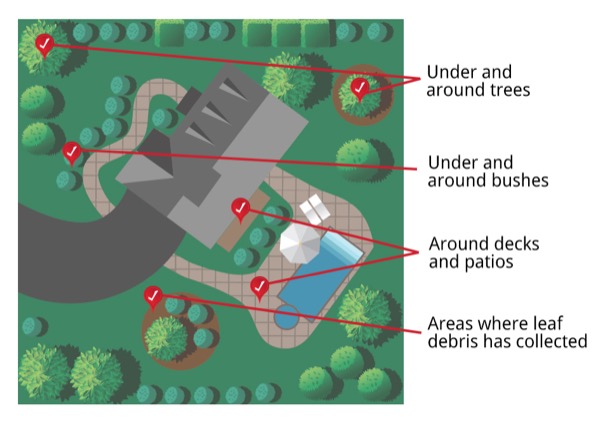
Fleas are small pests that live off the blood of their hosts. They will often infest an animal, biting the animal for blood which irritates the animal. Household pets can pick up fleas from the outdoors or other animals and bring them into the home.
If you suspect your pet may have fleas, there are three main places to inspect: your home, your property, and the pet itself. By learning where fleas live and locating areas of infestation, you can ensure your treatment applications are concentrated in the proper areas.
Inspect Your Pets for Fleas
Your dog or cat may have fleas if they frequently scratch, are more restless than usual, shake their head, or lose hair.
To inspect your pet for fleas, you will need the following:
- Flea Comb
- Bowl of soapy water
Begin by combing through your pet's fur slowly. After each stroke, inspect the comb for live fleas and flea dirt. Place any live fleas in the bowl of soapy water. If you are not sure if the dirt found on the comb is from fleas, place the dirt in the soapy water anyway. If the dirt turns red, it is flea dirt.
Adult fleas and flea feces can be found on infested animals. Be sure to double check the pet on their neck, groin area, around leg folds, and around the base of their tail.
If fleas are found on your pet, there are many pet flea control product available. The flea treatment guide will cover how to treat your pet.
Inspect Your Home
If you find fleas on your pet, you should also inspect your home for fleas. Spotting an infestation early will reduce the size of the infestation and the cost of treatment.
To inspect your home for fleas, you will need:
- Flashlight
- White socks
- Bowl of soapy water
Check the following areas for fleas:
- Pet bedding and crates - Examine your pet's bedding and inside their crate or beds closely for live fleas and flea dirt, which looks like coffee grounds. Like with inspecting your pet, if you are not sure if dirt found is flea dirt, place it in soapy water. If it turns red, it is flea dirt.
- Upholstered furniture - Check upholstered furniture and other places where you pet may lay for flea evidence
- Carpets and Rugs - Wearing a pair of white socks, slowly shuffle your feet over the carpet or rug. After several seconds, stop and use your flashlights to look for live fleas on the socks and the carpet. Place any live fleas in the bowl of soapy water.
Inspect Your Yard

If your pet has fleas there is a good chance they picked them up from your yard. Finding the flea infestation is the first step in outdoor flea control. You will need to treat outdoors to prevent your pet from becoming infested again.
To inspect your yard for a flea infestation, you will need:
- Flashlight
- Tall white socks
- A pair of shoes you don't mind getting dirty
Wear your white socks and shoes, slowly shuffle your feet through moist, shady areas around your yard. Shine a flashlight on your socks to inspect for live fleas every few seconds. Be sure to inspect the following areas:
- Any place your pet spends time playing or resting in outdoors
- Under and around trees and bushes
- Under and on decks or porches
- In areas where leaf debris has collected
If you find evidence of fleas, our guide on how to get rid of fleas will help you take the steps necessary to control them. Click the right arrow below to read more.



